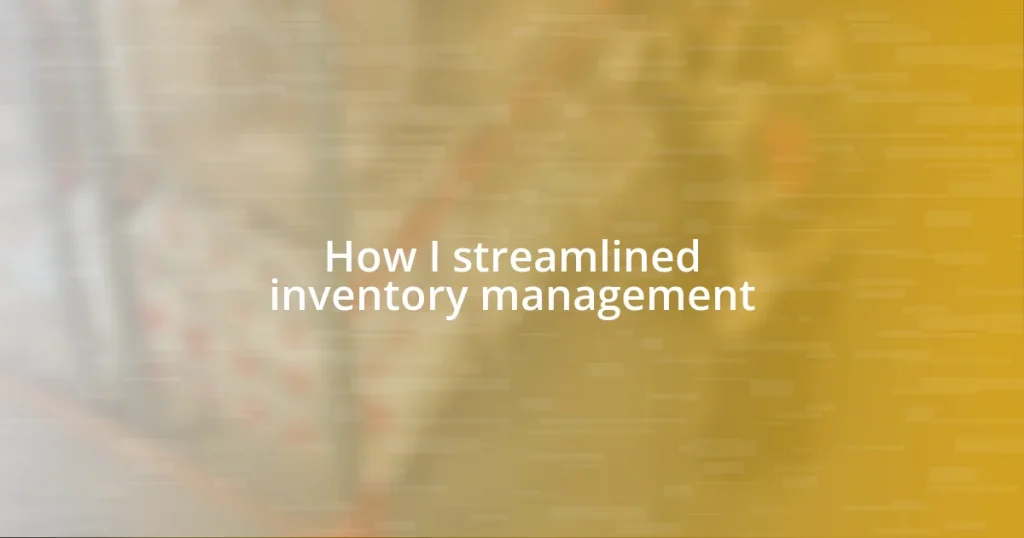Key takeaways:
- Accurate inventory tracking and real-time monitoring are crucial to prevent stockouts and overstocking, fostering smoother operations.
- Implementing technology solutions, such as software integration and automation, significantly enhances efficiency and reduces errors in inventory management.
- Regularly measuring inventory performance through data analytics and incorporating team feedback leads to continuous improvement and responsiveness to market demands.

Understanding inventory management processes
Inventory management processes can feel overwhelming at first glance, but they’re crucial for smooth operations. When I first delved into inventory management, I remember being struck by how interconnected everything is. Each part of the process—from stock receiving to tracking sales—plays a vital role in ensuring that products are available when customers need them.
Understanding these processes requires a keen eye for detail. For instance, I learned the hard way that regularly tracking stock levels can prevent costly overstocking or stockouts. Have you ever found yourself rushing to fulfill an order only to realize you’ve run out of a key item? That’s a sinking feeling I wouldn’t wish on anyone, and it underscored for me the importance of setting up a reliable inventory tracking system.
As I navigated through various inventory management methodologies, I discovered the significance of accurate forecasting. How can we predict what our customers will want? By analyzing sales data and trends, I found clarity; it transformed my approach to ordering stock. Now, when I think about inventory management, I see it not just as a process, but as an art of balancing supply and demand that requires both intuition and data-driven insights.

Identifying inventory management challenges
Recognizing the common obstacles in inventory management is the first step toward effective solutions. I recall a time when I juggled multiple suppliers, leading to discrepancies in stock availability. This lack of coordination not only created confusion but also frustrated my team and me, as orders arrived late or were incorrect. Understanding how these challenges manifest can help me establish a clearer path forward.
Another significant challenge is maintaining accurate stock levels, which can often feel like a guessing game. During a busy holiday season, I learned this lesson firsthand. I underestimated the demand for certain products, resulting in empty shelves and disappointed customers. It was a pivotal moment that made me realize the importance of real-time inventory monitoring. Implementing a robust tracking system transformed my inventory management, making it the backbone of my operations.
Lastly, I found that training my team adequately was another hurdle. Initially, newcomers struggled to grasp our inventory procedures, leading to mistakes that wasted time and resources. I remember a few stressful weeks spent fixing these errors, which underscored the need for comprehensive training and support. Investing in my team’s understanding of inventory management has since been one of the most rewarding choices I made, turning challenges into opportunities for growth.
| Challenge | Personal Experience |
|---|---|
| Supplier Coordination | Discrepancies in stock led to confusion and frustration |
| Accurate Stock Levels | Underestimating demand resulted in empty shelves during peak season |
| Team Training | Newcomers struggled with procedures, causing costly mistakes |

Implementing technology solutions
Implementing technology solutions has been a game-changer for me. When I started integrating software tailored for inventory management, I felt an immediate sense of relief. The chaotic stacks of spreadsheets were replaced by real-time data and efficiency. I vividly recall the first time I monitored stock levels from my phone; the convenience was nothing short of exhilarating. Here’s what I learned:
- Choose the Right Software: Finding a solution that meets specific business needs is crucial.
- Integrate Across Platforms: Ensure the technology syncs with other systems, like POS or supply chain management, for seamless operations.
- Cloud-Based Solutions: Opting for cloud technology offered me access to data anywhere, providing peace of mind when traveling.
As I navigated different technology options, I encountered various features that stood out. Automation captured my interest right away; the ability to set reorder alerts gave me freedom from constant manual checks. On one occasion, I remember a particularly busy week leading up to a big sale. I had automated the restock notifications, and thanks to that, I managed to avoid a potential disaster. Instead of scrambling at the last minute to replenish our stock, I felt composed and prepared. It was empowering to have technology handle the repetitiveness while I focused on strategic decisions. Here are a few actionable insights:
- Implement Barcode Scanning: This reduces human error and speeds up stock counting.
- Utilize Analytics Tools: Leveraging data can help forecast trends accurately.
- Train Your Team on New Tech: Comprehensive onboarding ensures everyone is on the same page and maximizes the use of the tools provided.
Investing in technology didn’t just optimize logistics; it transformed my overall approach to inventory management and alleviated some of the stress that had built up over the years. It’s a phase of continuous learning but one that I find deeply rewarding.

Streamlining order fulfillment practices
Streamlining order fulfillment practices has a profound impact on customer satisfaction and operational efficiency. I still remember a frantic day when we received an order for an unusually large shipment. My heart raced as I tried to coordinate multiple tasks simultaneously. However, making small adjustments in our order processing system smoothed out those frantic moments significantly. Now, I always prioritize clear communication with my team and implement clear guidelines. Have you experienced the chaos of last-minute rush orders? It’s exhausting, and I learned that effective communication is key to avoiding that scramble.
In re-evaluating our fulfillment practices, I found that optimizing pick and pack processes truly transformed my operations. One day, as I watched my team navigate the warehouse, I realized we could cut our picking time nearly in half by reorganizing product placement based on order frequency. Imagine the relief of seeing orders dispatched swiftly while my team felt less stressed. By creating a logical layout that placed high-demand items closer to the packing station, I not only improved efficiency but also enhanced morale. Who doesn’t want to feel like they’re getting things done seamlessly?
Lastly, integrating a reliable tracking system made all the difference in our fulfillment workflow. I recall the frustration of a day when a package went missing, and we had no way to trace it. Since implementing tracking that provides customers with real-time updates, that anxiety has vanished. Now, when an order ships, I feel like I’m giving my customers a little peace of mind. They can track their deliveries, and I can focus on ensuring every package is dispatched accurately rather than fielding countless inquiries. How liberating is it to shift from reactive management to proactive fulfillment? This transition has not only boosted our efficiency but has made my team feel more in control, and that’s incredibly rewarding.

Enhancing supplier relationships
Supplier relationships play a crucial role in inventory management, and I’ve learned that nurturing these connections can significantly streamline my processes. I remember a particular instance when a shipment was delayed due to unforeseen circumstances. Instead of panicking, I reached out to my supplier directly and was pleasantly surprised by their willingness to accommodate my needs. This open communication not only resolved the immediate issue but also strengthened our ongoing partnership. Have you ever had a moment where a little dialogue made all the difference in a stressful situation? It can transform the way you approach challenges.
Fostering trust with suppliers is something I prioritize in my business. I actively engage in regular check-ins and feedback sessions, sometimes over coffee or a casual lunch. These informal settings often lead to more candid discussions, allowing us to share insights about market trends. Honestly, I’ve found that those conversations have led to some innovative solutions that benefited both parties. How often do we underestimate the power of a simple chat? It can reveal new opportunities for collaboration that might be overlooked in a standard transactional relationship.
In addition to personal interactions, I’ve started using technology to enhance supplier relationships as well. Sharing inventory forecasts with them has been a game-changer. Last month, I shared my projected needs for an upcoming seasonal sale, which allowed my supplier to allocate resources effectively. The result? A seamless supply flow and a strengthened bond rooted in transparency and collaboration. It’s amazing how a little foresight can pave the way for smoother operations. What would it feel like to have suppliers genuinely invested in your success? For me, it’s empowering, and it’s made managing inventory feel far less daunting.

Measuring inventory performance
When I started measuring inventory performance, I realized just how vital data analytics is to my operations. Initially, I relied on gut feelings, but data revealed unexpected trends—like which products were gathering dust on the shelves. Has that ever happened to you? Discovering a few slow-moving items forced me to rethink my purchasing strategy entirely, leading to better inventory turnover and reduced holding costs.
I’ve also learned that key performance indicators (KPIs) are essential for tracking effectiveness. For instance, setting a target for inventory turnover ratios showed me how quickly I was converting stock into sales. There was a time when a particular category was underperforming, making me anxious about cash flow. But by analyzing the numbers, I could pivot my strategy, lift those products through promotions, and watch my sales dynamically shift. It’s almost exhilarating to see your efforts quantified and validated through KPIs.
Lastly, I began to understand the power of customer feedback in assessing inventory performance. One memorable day, I received an email from a loyal customer who was upset about a stockout on a favorite product. That feedback became a turning point for me. Instead of just looking at numbers, I started to listen more closely to what customers wanted. Now, I regularly gauge customer sentiments and preferences, ensuring my inventory aligns with actual demand. Isn’t it refreshing when inventory decisions are led by customer insight? By integrating these perspectives, I’ve fostered a more responsive approach to inventory management that truly reflects the needs of my clientele.

Continuously improving inventory strategies
Improving inventory strategies is an ongoing journey, and one of the best practices I’ve adopted is regular strategy reviews. There was a time when I held onto certain approaches for too long, convinced they were effective. It wasn’t until a colleague suggested a quarterly review that I realized the stagnation in my processes. By analyzing not just outcomes but also methods, I’ve discovered innovative strategies I hadn’t considered before. Have you ever taken a step back to reevaluate your practices? It can reveal enlightening insights.
I also prioritize employee feedback in my inventory management improvements. In one instance, a team member proposed a new tracking system that seemed practical but was dismissed initially. When I finally decided to test it out, I was amazed at how much smoother our operations ran. Their perspective illuminated inefficiencies I hadn’t recognized, reminding me that everyone on the team brings valuable insights to the table. Do you actively seek input from your team? It could breathe new life into your strategies.
Lastly, I believe in setting minimum viable inventory goals that evolve with market changes. A previous experience taught me that rigid targets limit adaptability. I used to set specific stock amounts, but as demand fluctuated, many items were either overstocked or understocked. By transitioning to flexible goals, I can react to real-time sales data, ensuring that I optimize stock without excess. Have you experienced the frustration of overcommitting to inventory? Adapting to a dynamic approach has transformed how I view inventory management.















